
| Ruger Bisley Super Blackhawk | ||
| Manufacturer | Sturm, Ruger & Co., Inc. | |
| Manufactured | Newport N.H. U.S.A. | |
| Model Number | 00871 | 00870 |
| Type Action | Single Action | |
| Caliber | 454 Casull | 480 Ruger |
| Capacity | 5 | |
| Frame/Cylinder/Barrel | Carpenter 465 Stainless | |
| Grips | Hardwood | |
| Trigger Pull (Actual) | 3 Lbs 8 Oz | 4 Lbs 6 Oz |
| Barrel Length | 6.5″ | |
| Rifling | 1:24″ | 1:18″ |
| Rear Sight | Adjustable | |
| Front Sight | Pinned Ramped Blade | |
| Type Safety | Transfer Bar | |
| Overall Length | 12 .40″ | |
| Overall Height | 5.75″ | |
| Cylinder Diameter | 1.730″ | |
| Weight | 50.4 Oz | 49.2 Oz |
| Lipsey’s Exclusive – MSRP $969 | ||
I suspect a lot of folks will be really glad to see the arrival of these Bisley Super Blackhawks; one in 454 Casull, the other in 480 Ruger. While the 44 Magnum Super Blackhawk is a compact power house in its own right, these cartridges take things up another notch or two for the big game hunter and for folks who carry a defensive handgun when traversing wilderness areas.
Yes, there are other manufacturers and custom shops competing for high performance, big bore single action business. The price tag for Freedom Arms big bore five shot starts at $2,300 with a 12+ month lead time and Magnum Research’s short cylinder BFR is priced at $1,200 in round numbers and it carries an extra half pound of weight in comparison to the Ruger.
On the custom front, quality shops charge between $2,500 and $3,500 in addition to the cost of a basic revolver to produce a big bore, five shot conversion. Typically, the donor revolver’s frame window is machined oversize to accept a slightly larger diameter 4140 chromoly or 17-4 stainless cylinder; slight increase in cylinder strength, but slightly weaker frame. The Ruger Bisley Super Blackhawk five shot retains the integrity of the revolver’s original design, but it is made stronger with the use of enhanced materials and manufacturing processes. The result is a high performance product, sold at moderate prices, backed and serviced under Ruger’s warranty.
The firearm pictured below is one of two that saw extended and extensive use during evaluation at Real Guns. When this photo was taken, each of the subject Bisley Super Blackhawks had already digested several hundred rounds of factory and handloaded ammo and both went on to consume many more without adverse affect. As a 65,000 PSI SAAMI cartridge, the 454 Casull version operates at higher pressure than a 300 Weatherby Magnum. The 480 Ruger is a larger caliber round that operates at a somewhat lower pressure, 48,000 PSI SAAMI.

Both Bisley Super Blackhawks held critical close tolerances and precise function; timing, cylinder gap, frame window, end shake, etc and accuracy. Verification was made with range rod, headspace gauges, micrometer, and caliper. Frame and barrel were continually inspected under magnification for cracks, erosion and any form of excessive wear. Targets were shot continually and ammunition was segregated into lots and sample chronographed. When it was over, both guns were given a good cleaning and they both looked like they did when they first came out of their respective boxes.
Some departures from other Super Blackhawks
The paragraph that follows has been edited: The original passage stated frame, cylinder and barrel were made of Carpenter 465 which is incorrect and is actually as follows.
The big bore Bisley Super Blackhawk’s primary strength is hiding in plain sight. While the frame is made of investment cast 415 stainless, the cylinder is made of heat treated Carpenter Custom 465® stainless, a premium quality, high strength, age-hardening stainless alloy and the barrel is made of 15-5 PH stainless steel. The 465 stainless material has improved tensile strength, fracture toughness, and excellent resistance to stress corrosion cracking. Subsequently, the 454 Casull and 480 Ruger versions in five shot form could have the same external cylinder dimensions as other Super Blackhawk models; a nominal 1.730″ in diameter and 1.780″ in length.
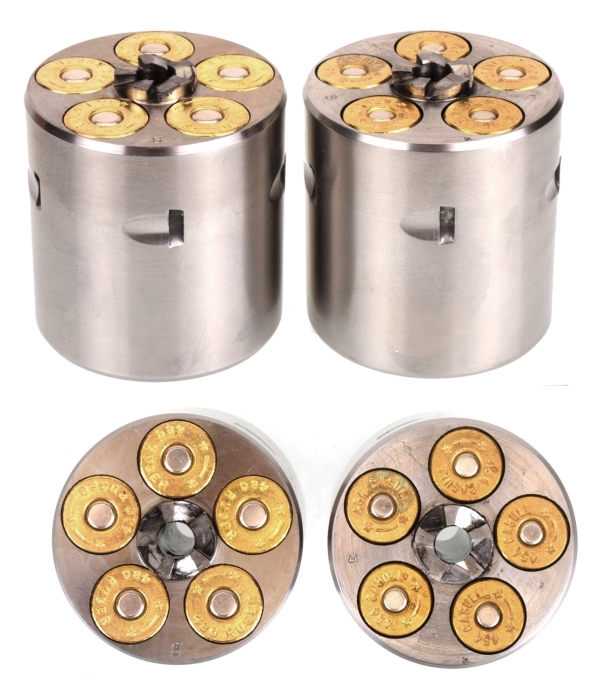
| Cartridge | Cylinder Diameter “ |
Cylinder Length “ |
Chamber Outer Wall Rear “ |
Chamber Outer Wall Front “ |
Chamber Adjacent Wall Rear “ |
Chamber Adjacent Wall Front “ |
| 480 Ruger | 1.730 | 1.780 | 0.063 | 0.078 | 0.135 | 0.165 |
| 454 Ruger | 1.730 | 1.780 | 0.076 | 0.088 | 1.162 | 0.188 |
A six shot 45 Colt Blackhawk cylinder has an adjacent chamber wall thickness of 0.060″ so, as indicated on the table, the result of changing to a five shot configuration is major in terms of beefing up chamber support. Additionally, the stop notches are relocated between chambers and not over a chamber’s wall. The 480 Ruger has slightly less cylinder beef than the 454 Casull version because of its increased cartridge diameter, but it operates at 17,000 PSI less pressure. Cylinders for both cartridges handle maximum length cartridges. The 454 Casull’s COL is 1.765″, which clears even 410 Grain Buffalo Bore ammo. The 480 Ruger has a shorter COL at 1.650″ so there is greater clearance.
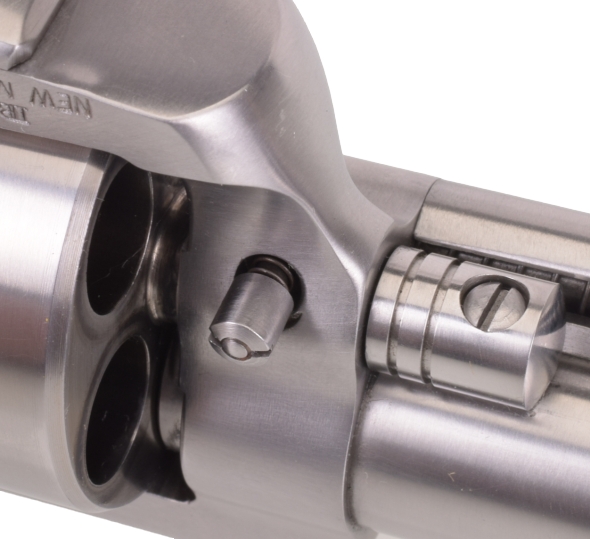
The base pin components of the five shot Bisley Super Blackhawk differ from other Super Blackhawks in that are heavier sprung and locked in place with a set screw. Neither the 454 Casull or 480 Ruger base pins bumped out under recoil and fit remained tight throughout.

After shooting a good number of rounds through revolvers with standard Super Blackhawk and Bisley style grip frames, particularly with heavy factory and handloaded ammunition, I’ve found the Bisley grip tends to spread the recoil out and it is more hand filling. The low hammer keeps clear of sights and is much easier to thumb without a major shift in grip. The result is that I can shoot much more accurately with Bisley grips and my hand and wrist don’t take a pounding over the course of long shooting sessions. The Bisley grip form is also commonly found on custom Linebaugh and Bowen hunting handguns when chambered for stout magnum cartridges.
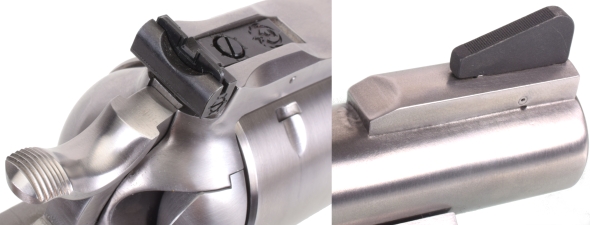
The Ruger Bisley Super Blackhawk rear sight is adjustable for windage and elevation. Each click shifts point of impact 3/4″ @25 yards. The ramped front sight is matte finished and has a serrated face to kill reflection. It is pinned to facilitate blade type and size changes. Through constant live fire, the sights stayed put with the exception of the 454 Casull’s rear sight pin drifting out perhaps 1/16″. It was tapped back in where it remained for the duration. As noted previously, both guns stayed tight. I thought I heard some rattling after a couple hundred rounds, but that turned out to be me.
Measureable performance..
The information below was gathered with each gun mounted in a Ransom Rest in an effort to gage mechanical accuracy of the Rugers, rather than gage my eyesight and shooting skills. Several changes needed to be made to the rest’s set up as, in standard form, both Ruger revolvers overpowered the Ransom Rest’s brake and were beating it within an inch of its mechanical life and chewing up expensive grip adapters. The first change was to replace wood screws used for mounting the rest with machine thread screws, load spreading fender washers and lock nuts to prevent the rest from working loose under heavy use and allowing point of impact to shift.

Second, two pounds of soft weight were draped over the top of each revolver’s frame, which dampened recoil induced rotation. The weight cut movement to less than 60% of the rest’s full travel and allowed the rest to settle consistently after each shot. Adding weight to the rest’s clamping plates to increase resistance would have caused the less restrained gun to tear up the rest’s soft grip adapters. Weight placed on the revolvers barrel would have stressed the barrel threads, possibly causing damage and certainly adversely influenced accuracy. I apologize for wandering off into the wilderness, but I wanted to define accuracy test conditions and approaches.
Ah yes, the compulsory ammo lineup. The gentleman third from the right, not wearing a hat, is an empty Cor-Bon DPX casing. The simple truth of the matter is that I ran through my supply before I took the picture and I didn’t want to fake its presence with a hastily assembled handload. Loaded with a lead free bullet, it would have looked just like the Federal cartridge to its left… only not nickel.

| Cartridge | Brand | Bullet Type |
Bullet Weight Grains |
Muzzle Velocity FPS |
Muzzle Energy Ft-Lbs |
25 Yard 5 Shot Group “ |
50 Yard 5 Shot Group “ |
| 454 Casull | Federal Fusion | JHP | 260 | 1310 | 991 | 0.7 | 1.5 |
| 454 Casull | Hornady XTP Mag | JHP | 300 | 1534 | 1568 | 1.0 | 1.7 |
| 454 Casull | Speer Handgun Hunting | JHP | 300 | 1456 | 1413 | 0.8 | 1.9 |
| 454 Casull | Buffalo Bore Heavy | Cast | 360 | 1385 | 1534 | 0.6 | 1.4 |
| 480 Ruger | Federal Premium Lead Free | JHP | 275 | 1521* | 1413 | 1.0 | 1.8 |
| 480 Ruger | Cor-Bon DPX | JHP | 275 | 1456 | 1295 | 0.9 | 2.0 |
| 480 Ruger | Hornady HP/XTP | JHP | 325 | 1340 | 1296 | 1.1 | 2.1 |
| 480 Ruger | Buffalo Bore Heavy | Cast | 410 | 1160 | 1225 | 0.9 | 1.8 |
| *Rated 1350 fps MV – Tested ammo from two boxes with two chronographs with very closeresults. No signs of excessive pressure. | |||||||
All of the ammo fired consistently and reliably and all cases ejected easily. Upon inspection prior to handloading empties, brass was in great shape. There were no pressure flattened primers, no backed out primers and no primer pockets were loose. There were no split or otherwise damaged cases.
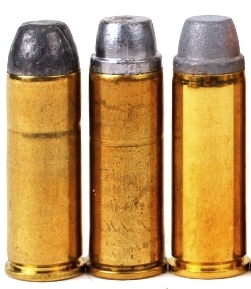
Some time was spent pushing 45 Colt ammo through the 454 Casull revolver, ammunition that shot well in other 45 Colt chambered revolvers. After shooting both 454 Casull and 480 Ruger ammo for an extended period of time, even +P level 45 Colt ammo was… relaxing to shoot.
| Type |
Brand |
Bullet Grains |
Actual FPS |
ME Ft/Lb |
25 Yard 5 Shot “ |
| 45 Colt | Magtech | 250 | 726 | 293 | 1.3 |
| 45 Colt | Buffalo Bore | 255 | 975 | 538 | 0.9 |
| 45 Colt | Handload | 255 | 1304 | 963 | 0.8 |
Accuracy was good, power was good, and I could see where a good deal of 45 Colt ammo would be going through the Ruger for recreational target shooting and medium size game hunting… hogs and deer. Yes, I realize there are very heavy loads for the 45 Colt that could handle bigger game, but at that level of hunting I’d rather go with the 454 Casull.
Shooting personality… Both powerful, but they are not the same
With this level of firepower, there is always the temptation to dramatize the big gun, big bore, big power aspects, but I think I should speak to the adults first. These are not guns for a novice to take to the range every day to pop off a few hundred rounds of ammo for recreational target practice. For one, it would not be an inexpensive outing as 454 Casull and 480 Ruger ammo run $30 to $50 per box of 20 rounds. With component bullet prices in the 25 cent to 50 cent per round range, handloaders definitely have an advantage.

Recoil for both is… meaningful, however, I found the 480 Ruger significantly easier to shoot than the 454 Casull version. My guess is that there is a certain intensity that comes with 65,000 PSI chamber pressure cartridges that puts an edge on recoil and certainly on report. I shot both with double ear protection. For the hunter, trapper, camper, fisherman who sights in, practices a bit and fires mostly at game or in self defense, either round is manageable and either has enough power to drop anything found within the Americas.
The Ruger is quite compact in comparison to other firearms chambered for similar cartridges. At 3 pounds it is about 50% lighter than an X Frame S&W and easy to carry in a belt holster. Both the 454 Casull and 480 Ruger generate a decent amount of muzzle blast, but I spent a good deal of time shooting both guns without any physical discomfort. I think the 480 Ruger runs a bit cleaner with lower pressure pushing less residue from the frame at the cylinder gap.
The new Bisley Super Blackhawk in 454 Casull or 480 Ruger are available exclusively through Ruger’s wholesale distributor Lipsey’s and can be ordered through your favorite dealer.
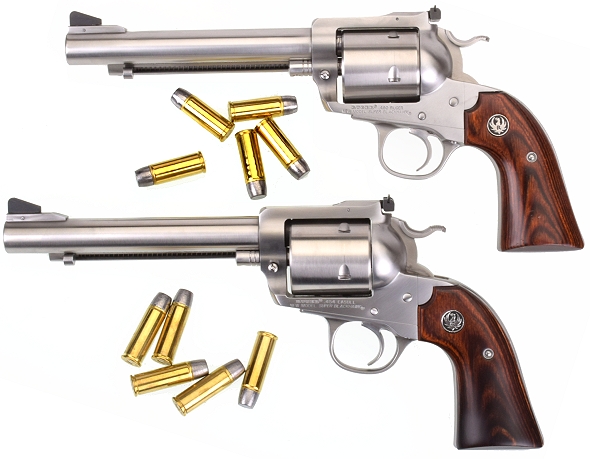

Email Notification